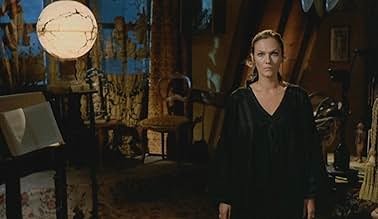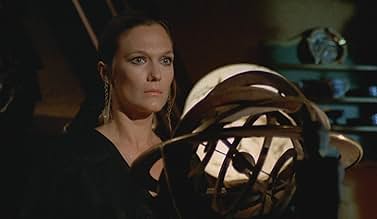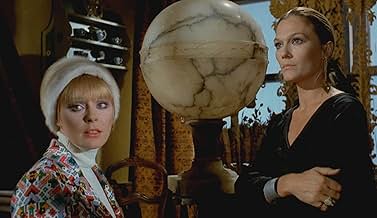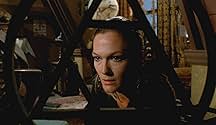IMDb RATING
5.9/10
4.6K
YOUR RATING
A young man, visiting the castle of a murderous ancestor in Austria, accidentally brings his dead relative back to life - searching for new victims.A young man, visiting the castle of a murderous ancestor in Austria, accidentally brings his dead relative back to life - searching for new victims.A young man, visiting the castle of a murderous ancestor in Austria, accidentally brings his dead relative back to life - searching for new victims.
- Awards
- 1 win total
Umberto Raho
- Inspector
- (as Humi Raho on US prints)
Luciano Pigozzi
- Fritz
- (as Alan Collins)
Lamberto Bava
- Man at Airport
- (uncredited)
Mario Bava
- Man Passing by the Castle
- (uncredited)
Pilar Castel
- Madeleine
- (uncredited)
Alfredo Leone
- Aircraft Passenger
- (uncredited)
Kathleen Leone
- Aircraft Passenger
- (uncredited)
Featured reviews
After the completion of his master's degree, Peter Kleist (Antonio Cantafora) travels to Austria to spend a leisure period doing nothing. He is welcomed in the airport by his uncle Dr. Karl Hummel (Massimo Girotti) and he asks if he could visit the castle of his ancestor, the evil Baron Otto von Kleist a.k.a. Baron Blood. In the Sixteenth Century, the sadistic baron was cursed by a witch Elisabeth Holle that he had burned at the stake and then he was killed by the locals in his Castle of Death. Peter meets the gorgeous Eva Arnold (Elke Sommer) that works restoring the castle and invites her to go with him to the castle after dinner to read an incantation written in an ancient parchment that would evoke the family course and bring the Baron back to life. After reading the magic words, the wind blows the parchment to the fireplace and it burns. When villagers mysterious disappear and Eva is chased by a weird man, they realize that they have released the Baron and they do not have the parchment anymore to call the incantation off. Their hope is that the clairvoyant and medium Christina Hoffmann (Rada Rassimov), who is a descendant of Elisabeth, might help them.
"Baron Blood" is another eerie and spooky movie by Mario Bava. The uncanny story of curse, witchcraft and resurrection is very well supported by the predictable screenplay that works well, but the stylish cinematography, the lighting and shadows and the camera work with unusual angle are impressive and give a creepy and nightmarish atmosphere to the feature. My vote is seven.
Title (Brazil): "Os Horrores do Castelo de Nuremberg" ("The Horrors of the Nuremberg Castle")
"Baron Blood" is another eerie and spooky movie by Mario Bava. The uncanny story of curse, witchcraft and resurrection is very well supported by the predictable screenplay that works well, but the stylish cinematography, the lighting and shadows and the camera work with unusual angle are impressive and give a creepy and nightmarish atmosphere to the feature. My vote is seven.
Title (Brazil): "Os Horrores do Castelo de Nuremberg" ("The Horrors of the Nuremberg Castle")
Imagine you knew the incantation that would bring Dracula back to life. Sure, he had a habit of murdering people from time to time, but wouldn't it be really amazing to see him in the flesh? This is essentially the premise of 'Baron Blood', although the dreaded Otto Von Kleist of the tale is far more Vlad than Dracula - a man who would happily spend the afternoon strapping someone to a rack and cutting their fingers off as we would spend it renting a DVD. Flash forward to the 20th century, where his great great great etc grandson Peter, who decides to pay a visit to his homeland of Austria during a gap year to get in touch with his roots, stumbles across just such an incantation. The chance to meet his infamous ancestor: who could resist?
Director Mario Bava shows what competent continental rivals to Hammer studios could do with the same formula. Classic horror aficionados will find much to compare, with the same ancient evils resurrected plot wise, the same helpless busty heroines, and the same near blackness films of the 70s often had, forcing the viewer to reach for the brightness control. There is even the obligatory witch to pull the story several notches away from horror in the direction of the occult, evoking "Cry Of The Banshee" to name one British contemporary. Yet despite being typical of the genre, 'Baron Blood' stands out in a few areas. Bava takes us to a real Austrian castle, the magnificent Berg Kreuzenstein, which oozes character all its own. It's also set in then-present day Austria. Hammer would often take us back a century for the action, although to be fair, this was already the era of Dr Phibes, which showed a monster in the 20th Century would probably scare the viewer more. Then, if you've got the US version, there's Les Baxter's soundtrack, which strongly suggests he didn't know it was a horror film. Why, was Stelvio Cipriani's original score deemed to scary for Americans, i.e - doing what it was supposed to do?
On the acting side of things, the cast do a fair job. Nothing award-winning, but they have just enough conviction to make you believe them. Rising above this however is the exceptional Joseph Cotton, as the mysterious Alfred Becker, a millionaire who suddenly appears out of the ether to buy the baron's castle. Given that the script is not one to hide its twists very well, Cotton is a welcome compensation. You can't help but look at him whenever he appears, wondering what he'll do next.
Overall, 'Baron Blood' breaks no new ground, but gives the genre fan most of the things they would expect, with some excellent location work and a memorable villain into the bargain. English-language viewers may scratch their heads at the mystifying score, but don't let it put you off - this is just the ticket for late-evening viewing.
Director Mario Bava shows what competent continental rivals to Hammer studios could do with the same formula. Classic horror aficionados will find much to compare, with the same ancient evils resurrected plot wise, the same helpless busty heroines, and the same near blackness films of the 70s often had, forcing the viewer to reach for the brightness control. There is even the obligatory witch to pull the story several notches away from horror in the direction of the occult, evoking "Cry Of The Banshee" to name one British contemporary. Yet despite being typical of the genre, 'Baron Blood' stands out in a few areas. Bava takes us to a real Austrian castle, the magnificent Berg Kreuzenstein, which oozes character all its own. It's also set in then-present day Austria. Hammer would often take us back a century for the action, although to be fair, this was already the era of Dr Phibes, which showed a monster in the 20th Century would probably scare the viewer more. Then, if you've got the US version, there's Les Baxter's soundtrack, which strongly suggests he didn't know it was a horror film. Why, was Stelvio Cipriani's original score deemed to scary for Americans, i.e - doing what it was supposed to do?
On the acting side of things, the cast do a fair job. Nothing award-winning, but they have just enough conviction to make you believe them. Rising above this however is the exceptional Joseph Cotton, as the mysterious Alfred Becker, a millionaire who suddenly appears out of the ether to buy the baron's castle. Given that the script is not one to hide its twists very well, Cotton is a welcome compensation. You can't help but look at him whenever he appears, wondering what he'll do next.
Overall, 'Baron Blood' breaks no new ground, but gives the genre fan most of the things they would expect, with some excellent location work and a memorable villain into the bargain. English-language viewers may scratch their heads at the mystifying score, but don't let it put you off - this is just the ticket for late-evening viewing.
The one thing this film has going for it is a nice atmosphere for horror fans... fog/smoke, old castles, incantation for raising the dead, scary torture chamber, weird but well filmed scenes, a witch and, above all, a mad sadist ghost or demon! The story is alright enough, not to bad.
Joseph Cotten as Baron Otto von Kleist aka Baron Blood / Alfred Becker was good - he was better in this horror film than I anticipated (I really don't think of Cotten as a horror actor that's why I mentioned it).
One thing about these types of films - the living dead or undead always seems to have plenty of money - filthy rich they are! How does a long time dead man get such riches without selling off his gold? The money has changed over the years (I think in every country) so how can he spend it - sell it I suppose to those interested in old money I guess. Whatever, I still by into it for a movie. LOL.
Not a bad film to watch for fans of the older horror - in particular the Italian horror films.
6/10
Joseph Cotten as Baron Otto von Kleist aka Baron Blood / Alfred Becker was good - he was better in this horror film than I anticipated (I really don't think of Cotten as a horror actor that's why I mentioned it).
One thing about these types of films - the living dead or undead always seems to have plenty of money - filthy rich they are! How does a long time dead man get such riches without selling off his gold? The money has changed over the years (I think in every country) so how can he spend it - sell it I suppose to those interested in old money I guess. Whatever, I still by into it for a movie. LOL.
Not a bad film to watch for fans of the older horror - in particular the Italian horror films.
6/10
The closet thing to a remake of Mask of Satan(1960) that Mario Bava ever did was this film. The plotline is the opposite of Mask of Satan(1960) where in this film the witch is not evil. Gli Orrori del Castello di Norimberga/Baron Blood(1972) is an atmospheric supernatural thriller with marvelous cinematography and some good scare scenes. The main source of inspiriation for Baron Blood(1972) is Antonio Margheriti's The Virgin of Nuremberg(1963). Its interesting that Baron Blood(1972) takes place in the birth country of Adolph Hitler. Baron Otto Von Kleist seems to symbolize the atrocities committed by the nazis during the mid 1930s to mid 1940s.
Mario Bava did Baron Blood(1972) right after the controversial blood letting of A Bay of Blood(1971). Baron Blood has some gore scenes but without frequency and show stopping manner of Mario Bava's previous film. Baron Blood was the first and only time that Mario Bava did a film away from home as he didn't like to leave Italy. The music by Stelvio Cipriani is very good. The chase scenes in the film are some of Baron Blood's most exciting scenes. The death of Fritz is a reference to La Maschera del Demonio(1960) and Sei Donne Per L'Assassino(1964).
Elke Sommer doesn't do much in the role of Eva but she does look arousing in short dresses and mini skirts. Elke Sommer would give a much better performance in her next film for Mario Bava called Lisa E il Diavolo/Lisa & the Devil(1974). Joseph Cotten's performance as the evil Baron Otto Von Kleist brings to mind his role as the "Merry Widow Murderer" in Alfred Hitchcock's Shadow of a Doubt(1943). Baron Blood(1972) is not in the same league as the best of Bava's supernatural films such as La Maschera del Demonio/Mask of Satan(1960), La Frusta E il Corpo/Whip & the Body(1963), Operazione Paura/Kill Baby Kill!(1968), and Lisa E il Diavolo/Lisa and the Devil(1974) but is still better than any horror film from Hollywood from the 1990s til now. The set designs for the castle are excellent. The mysterious figure that appears on top of the castle at the end of the film gives me chills everytime I watch this movie.
Mario Bava did Baron Blood(1972) right after the controversial blood letting of A Bay of Blood(1971). Baron Blood has some gore scenes but without frequency and show stopping manner of Mario Bava's previous film. Baron Blood was the first and only time that Mario Bava did a film away from home as he didn't like to leave Italy. The music by Stelvio Cipriani is very good. The chase scenes in the film are some of Baron Blood's most exciting scenes. The death of Fritz is a reference to La Maschera del Demonio(1960) and Sei Donne Per L'Assassino(1964).
Elke Sommer doesn't do much in the role of Eva but she does look arousing in short dresses and mini skirts. Elke Sommer would give a much better performance in her next film for Mario Bava called Lisa E il Diavolo/Lisa & the Devil(1974). Joseph Cotten's performance as the evil Baron Otto Von Kleist brings to mind his role as the "Merry Widow Murderer" in Alfred Hitchcock's Shadow of a Doubt(1943). Baron Blood(1972) is not in the same league as the best of Bava's supernatural films such as La Maschera del Demonio/Mask of Satan(1960), La Frusta E il Corpo/Whip & the Body(1963), Operazione Paura/Kill Baby Kill!(1968), and Lisa E il Diavolo/Lisa and the Devil(1974) but is still better than any horror film from Hollywood from the 1990s til now. The set designs for the castle are excellent. The mysterious figure that appears on top of the castle at the end of the film gives me chills everytime I watch this movie.
Mario Bava's BARON BLOOD is a fine a tribute to the monster movies of Hollywood's golden age. So evocative of that period is this film that it takes not even a moment's thought to mentally recast Boris Karloff as the Baron, Nan Grey as his intended victim and to tune away the vivid Technicolor into haunting black and white.
As in FRANKENSTIEN or THE MUMMY, the evil in the film is unwittingly unleashed upon the world by the film's hero. In this case it is American Peter Kleist, who returns to the German castle of his ancestor Baron Otto Von Kleist. Even though he is aware that his ancestor, nicknamed "Baron Blood" was a sadistic monster who butchered and tortured the people of the countryside, Peter foolishly recites an ancient spell capable of resurrecting the Baron. The restored Von Kleist immediately resumes his homicidal ways, and now Peter, assisted by the beautiful Elke Sommer as a local historian, must find a way to undo what he has thoughtlessly wrought.
In the classic horror films of the 1930's the monsters were iconic and unforgettable, while the heroes were bland and almost entirely irrelevant. After all, who remembers who played the "hero" opposite Lugosi in Dracula or Karloff in THE MUMMY? (For trivia's sake it was David Manners in both films.) No, the villain/monster may have spent much of the picture lurking about off screen, or skulking in the shadows, but nevertheless he was always indisputably the star of the show.
BARON BLOOD maintains this link to its cinematic forbearers. Antonio Cantafora's Peter Kleist is satisfactory, but eminently forgettable, while Joseph Cotton, obviously having a ball, is terrific in his villainous role. Cotton's performance as the resurrected Von Kleist is spot on perfect, filled with evil charm and malevolent glee. He dominates the screen in the best tradition of the movie monsters of old.
In fact, there is only one significant departure from the classic monster films. Even in the days before the Hayes Commission, blood and gore were rarely seen and usually only suggested in Hollywood motion pictures. BARON BLOOD was produced without such restrictions and, though mild when compared to more recent horror films, it does contain some explicit moments that would have been completely unacceptable in the 1930's. Even as a tribute to the grand old days, it must remembered that BARON BLOOD was produced to appeal to a contemporary 1970's audience. Bava however realized that things modern will inevitably intrude upon the classic, and made light of this by placing soda pop machines in the halls of the Gothic Von Kleist castle and having prerecorded screams available in the Baron's torture chamber at the flip of a switch.
Not as arty as LISA AND THE DEVIL, not as graphic as BAY OF BLOOD, BARON BLOOD is often unjustly overlooked, or simply dismissed as a minor effort of Mario Bava's later period. Such hasty judgments do the film a great disservice. If BARON BLOOD has less of the striking cinematography of Bava's best films, it must be argued that such innovation would be out of place in a film striving to recapture the look and atmosphere of the original Hollywood horror movies. If one accepts the movie for what it is, a fine tribute to the genre's past, then BARON BLOOD is a great success, both as a homage and as work unto itself.
BARON BLOOD has been released in numerous VHS and laserdisc editions. The DVD release from Image Entertainment is probably the best example of the film currently available, featuring an uncut 1.85:1 widescreen presentation of the film, complete with the original European musical score, which was replaced when the film was released theatrically in North America.
As in FRANKENSTIEN or THE MUMMY, the evil in the film is unwittingly unleashed upon the world by the film's hero. In this case it is American Peter Kleist, who returns to the German castle of his ancestor Baron Otto Von Kleist. Even though he is aware that his ancestor, nicknamed "Baron Blood" was a sadistic monster who butchered and tortured the people of the countryside, Peter foolishly recites an ancient spell capable of resurrecting the Baron. The restored Von Kleist immediately resumes his homicidal ways, and now Peter, assisted by the beautiful Elke Sommer as a local historian, must find a way to undo what he has thoughtlessly wrought.
In the classic horror films of the 1930's the monsters were iconic and unforgettable, while the heroes were bland and almost entirely irrelevant. After all, who remembers who played the "hero" opposite Lugosi in Dracula or Karloff in THE MUMMY? (For trivia's sake it was David Manners in both films.) No, the villain/monster may have spent much of the picture lurking about off screen, or skulking in the shadows, but nevertheless he was always indisputably the star of the show.
BARON BLOOD maintains this link to its cinematic forbearers. Antonio Cantafora's Peter Kleist is satisfactory, but eminently forgettable, while Joseph Cotton, obviously having a ball, is terrific in his villainous role. Cotton's performance as the resurrected Von Kleist is spot on perfect, filled with evil charm and malevolent glee. He dominates the screen in the best tradition of the movie monsters of old.
In fact, there is only one significant departure from the classic monster films. Even in the days before the Hayes Commission, blood and gore were rarely seen and usually only suggested in Hollywood motion pictures. BARON BLOOD was produced without such restrictions and, though mild when compared to more recent horror films, it does contain some explicit moments that would have been completely unacceptable in the 1930's. Even as a tribute to the grand old days, it must remembered that BARON BLOOD was produced to appeal to a contemporary 1970's audience. Bava however realized that things modern will inevitably intrude upon the classic, and made light of this by placing soda pop machines in the halls of the Gothic Von Kleist castle and having prerecorded screams available in the Baron's torture chamber at the flip of a switch.
Not as arty as LISA AND THE DEVIL, not as graphic as BAY OF BLOOD, BARON BLOOD is often unjustly overlooked, or simply dismissed as a minor effort of Mario Bava's later period. Such hasty judgments do the film a great disservice. If BARON BLOOD has less of the striking cinematography of Bava's best films, it must be argued that such innovation would be out of place in a film striving to recapture the look and atmosphere of the original Hollywood horror movies. If one accepts the movie for what it is, a fine tribute to the genre's past, then BARON BLOOD is a great success, both as a homage and as work unto itself.
BARON BLOOD has been released in numerous VHS and laserdisc editions. The DVD release from Image Entertainment is probably the best example of the film currently available, featuring an uncut 1.85:1 widescreen presentation of the film, complete with the original European musical score, which was replaced when the film was released theatrically in North America.
Did you know
- TriviaSometime around 1997, there emerged a massive Internet hoax which claimed that a Siberian borehole had penetrated the Earth's crust into Hell itself, with "proof" being an audio recording of the screaming souls of the damned. This urban legend (variously known as the "Siberian Sounds of Hell" or "The Well to Hell" hoax) featured in many tabloids, and was even cited by some Christian groups as hard proof of a real Hell. The sound effects supposedly recorded within the borehole were actually a combination of story elements from a radio broadcast "Quiet Please - The Thing on the Fourble Board", and audio lifted from this film.
- GoofsWhile being chased through the streets by Baron Blood, Eva runs into the same alley twice (with the same advertisement plastered against the building).
- Alternate versionsItalian version runs 98 minutes; USA version, titled Baron Blood (1972) removes about eight minutes of footage for pacing.
- ConnectionsEdited into Baron Blood: Die Burg des Teufels - Locationtour (2017)
- How long is Baron Blood?Powered by Alexa
Details
- Release date
- Countries of origin
- Languages
- Also known as
- Baron Vampire
- Filming locations
- Production companies
- See more company credits at IMDbPro
- Runtime1 hour 38 minutes
- Sound mix
- Aspect ratio
- 1.85 : 1
Contribute to this page
Suggest an edit or add missing content

































